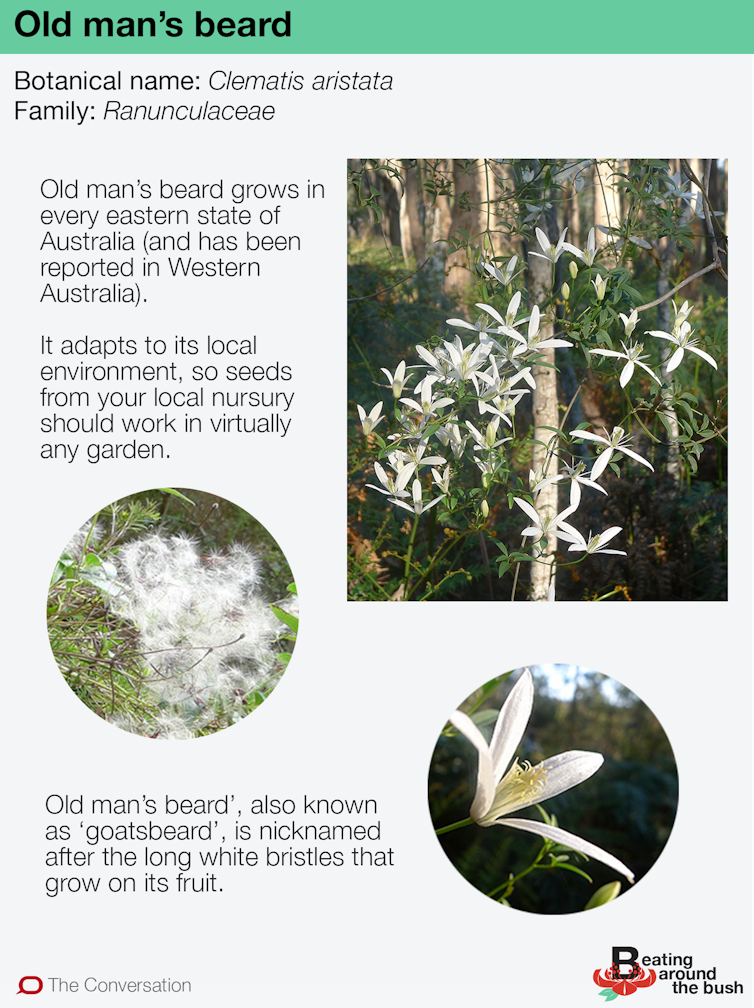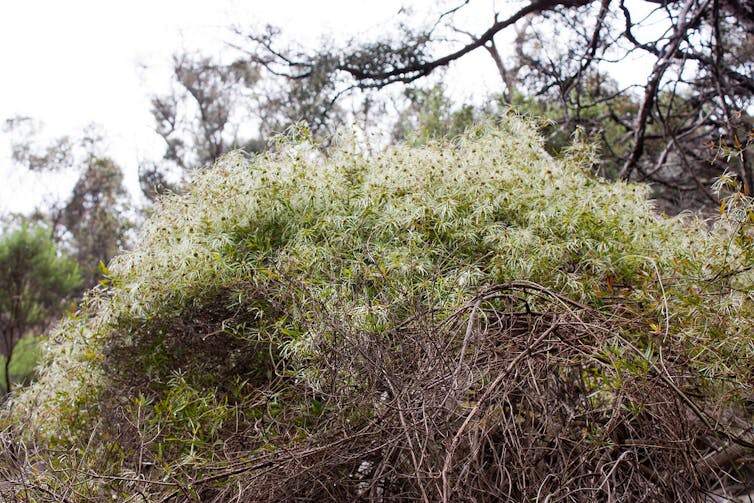Old man's beard is a star climber for Australian gardens
- Written by Gregory Moore, Doctor of Botany, University of Melbourne
Sign up to Beating Around the Bush, a series that profiles native plants: part gardening column, part dispatches from country, entirely Australian.
Clematis aristata is a gem of a native climbing plant. Commonly known as Australian clematis, goatsbeard or old man’s beard, these names and the species name aristata (Latin for bearded) all refer to the bristle-like appendages to the fruit.
Although there are more than 300 Clematis species worldwide, only six are native to Australia. Old man’s beard’s flowers are a little more modest than its cousins.
Read more: Plant fossils have a lot to teach us about Earth's history
Clematis aristata is widely distributed in southeastern Australia and has been recorded in all of the eastern mainland states, as well as in Tasmania and South Australia. There is a record of it in Western Australia from around a century ago, but this has not been confirmed in recent times.
With such a wide natural range, it is not surprising that in occurs in many different habitats and soil types. Herein lies one of the great attributes of C. aristata: it has many local forms and is easy to propagate and grow in almost any climate or soil type.
 The Conversation, CC BY
Its flowers are white or cream-coloured, and while they are only 2-3cm across they occur in such great numbers they make a fine show. As a climber, they do have the capacity to smother a host, but more often than not the two plants live long lives together without doing harm. In the garden, with a little careful management and pruning, old man’s beard can grow for decades without causing problems while putting on a fine floral display each spring.
One of the wonders of seeing old man’s beard in it natural habitat is the diverse places and spaces it occupies. In the tall wet forests of the east coast you can see it flowering high in the canopies of 60-metre eucalypts, but on the clays of the windswept basalt plains, it appears as flowering orb growing over a shrubby acacia or grevillea. You can also find it growing on an old fence, a rocky outcrop, or simply growing as a scrambler.
Read more:
The mysterious Pilostyles is a plant within a plant
In some parts of Australia, the roots of the species were used as a food source by Indigeneous communities. Its sinuous branches were used like string or laces by some early settlers, and it is hard to imagine that Indigenous people did not use it in this way on some occasions. However, it breaks easily and becomes quite brittle as it dries, and so is useful only in short lengths and for short periods.
It is easy to propagate from seed, and in some places it self-seeds readily and young seedlings can be dug up and grown on with good success rates. It can also be grown from semi-hardwood cuttings in a good propagating mix and a little shelter. You may have heard old man’s beard likes cool roots, good sun and moist soil, but this depends on where you source your plants and seeds.
The Conversation, CC BY
Its flowers are white or cream-coloured, and while they are only 2-3cm across they occur in such great numbers they make a fine show. As a climber, they do have the capacity to smother a host, but more often than not the two plants live long lives together without doing harm. In the garden, with a little careful management and pruning, old man’s beard can grow for decades without causing problems while putting on a fine floral display each spring.
One of the wonders of seeing old man’s beard in it natural habitat is the diverse places and spaces it occupies. In the tall wet forests of the east coast you can see it flowering high in the canopies of 60-metre eucalypts, but on the clays of the windswept basalt plains, it appears as flowering orb growing over a shrubby acacia or grevillea. You can also find it growing on an old fence, a rocky outcrop, or simply growing as a scrambler.
Read more:
The mysterious Pilostyles is a plant within a plant
In some parts of Australia, the roots of the species were used as a food source by Indigeneous communities. Its sinuous branches were used like string or laces by some early settlers, and it is hard to imagine that Indigenous people did not use it in this way on some occasions. However, it breaks easily and becomes quite brittle as it dries, and so is useful only in short lengths and for short periods.
It is easy to propagate from seed, and in some places it self-seeds readily and young seedlings can be dug up and grown on with good success rates. It can also be grown from semi-hardwood cuttings in a good propagating mix and a little shelter. You may have heard old man’s beard likes cool roots, good sun and moist soil, but this depends on where you source your plants and seeds.
 Clematis aristata growing in Werribee Gorge State Park, Victoria.
Rexness/Flickr, CC BY-SA
Different populations of old man’s beard have adapted to their local environments and so it is always worth getting your plants and seeds from your local native nursery.
The old man’s beard from the temperate forest of the east coast does not do well on the basalt plains, but then again the plants from the basalt plains do not grow well on good soils in cooler, rainy sites. One of the joys of working with old man’s beard is that if you use locally indigenous plants, they will grow quickly without the need for much care and they are usually free of pests and disease. In the poorly structured clay soils of the great basalt plain, with the annual rainfall often below 600mm, it is amazing to see it grow so well without the need for irrigation.
Read more:
Native cherries are a bit mysterious, and possibly inside-out
Like most plants, if you are growing old man’s beard in garden beds it will benefit from a 75-100mm layer of organic mulch containing both fine and coarse material – a mix of native plant leaf litter and twigs will do nicely. Once they have flowered, they can look a bit untidy and some people do not like the look of the bristly fruits as they dry, so a bit of light pruning can be beneficial. Annual pruning will also keep old man’s beard growing where you want it and ensure it is not causing problems to other plants in your garden.
So if you want a native climbing plant that will give you years of spectacular and worry-free flowering, give C. aristata some thought. All you have to do is get hold of a locally growing variant, plant it, and step back before it starts growing over you!
Clematis aristata growing in Werribee Gorge State Park, Victoria.
Rexness/Flickr, CC BY-SA
Different populations of old man’s beard have adapted to their local environments and so it is always worth getting your plants and seeds from your local native nursery.
The old man’s beard from the temperate forest of the east coast does not do well on the basalt plains, but then again the plants from the basalt plains do not grow well on good soils in cooler, rainy sites. One of the joys of working with old man’s beard is that if you use locally indigenous plants, they will grow quickly without the need for much care and they are usually free of pests and disease. In the poorly structured clay soils of the great basalt plain, with the annual rainfall often below 600mm, it is amazing to see it grow so well without the need for irrigation.
Read more:
Native cherries are a bit mysterious, and possibly inside-out
Like most plants, if you are growing old man’s beard in garden beds it will benefit from a 75-100mm layer of organic mulch containing both fine and coarse material – a mix of native plant leaf litter and twigs will do nicely. Once they have flowered, they can look a bit untidy and some people do not like the look of the bristly fruits as they dry, so a bit of light pruning can be beneficial. Annual pruning will also keep old man’s beard growing where you want it and ensure it is not causing problems to other plants in your garden.
So if you want a native climbing plant that will give you years of spectacular and worry-free flowering, give C. aristata some thought. All you have to do is get hold of a locally growing variant, plant it, and step back before it starts growing over you!
 Sign up to Beating Around the Bush, a series that profiles native plants: part gardening column, part dispatches from country, entirely Australian.. Read previous instalments here.
Sign up to Beating Around the Bush, a series that profiles native plants: part gardening column, part dispatches from country, entirely Australian.. Read previous instalments here.
Authors: Gregory Moore, Doctor of Botany, University of Melbourne
Read more http://theconversation.com/old-mans-beard-is-a-star-climber-for-australian-gardens-96022



